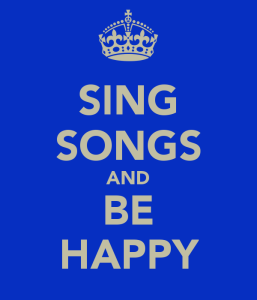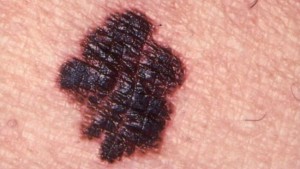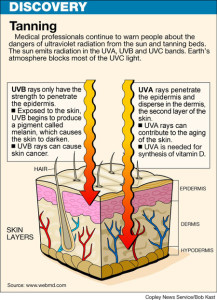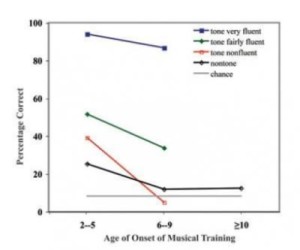In my own anecdotal experience, singing always helps me to relax and de-stress. Although it can be hard to find time to do it with my busy schedule, I noticed that I’m always more positive and productive after I’ve practiced. From that I began to wonder, does singing improve your mood? The research I was able to find on the topic only looked at group singing, but it was  interesting nevertheless.
interesting nevertheless.
Group Singing in Healthy Communities
If group singing can improve mood, then it should be able to do so in typical communities. “The Effects of Group Singing on Mood” sought to explore whether that statement would hold up to an experiment. In the experiment,t 3 groups of people in 3 different locations were randomly allocated to singing session groups and listening groups. Before and after they sang or listened, the participants were given the Profile of Mood States Questionnaire. One week later the test was re-administered. The singing session itself lasted a half an hour and consisted of some up tempo, non-English songs, sung in a group. The study had 2 hypotheses to look at.
Null 1: Singing would not affect mood
Alternative 1: Singing would significantly affect mood
Null 2: Singing would have the same effect as listening
Alternative 2: Singing would have statistically significant improvements in mood change
The study was able to reject the Null 1 hypothesis, but was unable to reject Null 2. Basically, they found that singing did improve mood, but listening did too. The study is careful to point out that the reaction to the singing was more positive than listening, but the difference wasn’t big enough to be statistically significant.
Problems
Here’s the issue with the study in my eyes, there was no true control group. How can the researchers clearly conclude anything without a control group? Without the baseline comparison of someone just relaxing for 30 minutes, it is unclear how significant the differences are from someone just given some free time. This left room for all sorts of confounding variables over the period of time after the singing session and before the third administration of the mood test. The other potential problem in the study could be found through the method of recruitment. There may be a little bit of voluntary bias because the participants answered an advertisement for the study. Perhaps only those who enjoy singing decided to go, which may muddle the results.
Group Singing and Pain Relief
Now that we’ve seen that singing and listening to music has an effect on healthy patients, we need to ask if it is still beneficial for those who aren’t as healthy? “The Impact of Group Singing on Mood, Coping, and Perceived Pain in Chronic Pain Patients Attending a Multidisciplinary Pain Clinic” takes a look at one group of 77 such people. This study is more extensive than the first on in terms of its length. Rather than participating in just one session, subjects were exposed to 9 separate half an hour sessions. This group’s control was a group of people who listened to music while exercising. In an interesting twist, there were a group of people selected to sing who would not, and were thus treated as an unrandomized second control group. Much like the first study, scientists were testing to see if there was a significant difference in listening to singing and actively participating in singing. This second study had another leg up on the previous one, because it looked at several types of mood improvement measured by the results 5 questionnaires (including POMS) before, after, and 6 months after treatment was completed.
The study found that both singing and listening to music while exercising created short term mood improvements, but that there was no statistically significant difference between the two. Singers were better at dealing with some of their pain, but the amount failed the statistical significance mark. Furthermore, at the 6 month mark, the difference was no longer there. So while there may have been a benefit to participating in the singing sessions, it was not a large one.
Problems:
Patients were suitably randomized and both control and experimental groups participated in the same baseline pain-management program to prevent third variables. The sample size was relatively small, 77 participants, but that was due to the specific criteria needed to participate. The other main problem is that the pain-management program was happening at the same time as the singing program, meaning that statically significant result from singing could be masked by the overall improvement of all who participated in the study.
Why it Matters:
There are two reasons that these studies are important to look at. The first is the benefit of music. If group singing or listening to music is in fact able to improve mood, as shown in the first study, it might be useful to utilize this information for people who need a spirit lift. For example, I would love to see the application of this to the problem of depression. Could group singing or listening benefit those who are depressed or is depression just too severe? It would be interesting to see more types of musical experiments conducted, and if they yield positive results, incorporated into clinical practice. Singing and music playing are both extremely cost-effective therapeutic methods, particularly because one instructor can teach many students simultaneously. Right now there is an indication that there may be something to singing for health, but not enough research to support it.
The second reason I think these studies are important is their application to everyday life. If music can improve mood, it might be beneficial to use this information in atypical settings such as the workplace. If your employees are all in a good mood, they are less likely to cause conflict and problems with each other. These studies also seem to support the idea of music in schools. People often fight over the importance of music and its relevance to the school curriculum. If music is providing a clinical benefit in a way that talking about biochemistry can’t, who’s to say that it should be taken away?
Conclusion:
More research on this topic should definitely be done, but the tentative conclusion is that group signing, or even listening to a lesser extent, can have a positive effect on a person’s mood. If you feel yourself sinking down into a funk, it may be worth a shot to belt out a few tunes or turn up the Spotify. You may find yourself in a better mood because of it. Some of you might be saying “Meghan, you haven’t determined that there is a statistically significant benefit to doing this. Why should I?” The answer is simple. There’s really no harm that could come of it, and you might reap in some benefits at the cost of only a half an hour of your time. For me, it works. For some of the people in the study, it worked. If you find it doesn’t work for you, don’t do it, but it can’t hurt to try it out!
Do you agree with my conclusion? Do you think music can have a physical impact? Does music help or hurt your mood? Let me know in the comments below!
That’s all for now.
Meghan














 . Everyone has heard of the composers like Mozart who composed complicated musical pieces at amazingly young ages. Today we are going to focus on a different talent: perfect pitch. Some people seem to be born with the ability to constantly sing at perfect pitch. Perfect pitch is the ability to sing a note or tone with extreme accuracy to the true tone. For example, if you told someone with perfect pitch to sing a C note, they could do so without hearing it on any instrument. Most people and musicians have what is called
. Everyone has heard of the composers like Mozart who composed complicated musical pieces at amazingly young ages. Today we are going to focus on a different talent: perfect pitch. Some people seem to be born with the ability to constantly sing at perfect pitch. Perfect pitch is the ability to sing a note or tone with extreme accuracy to the true tone. For example, if you told someone with perfect pitch to sing a C note, they could do so without hearing it on any instrument. Most people and musicians have what is called 
 know is that there is
know is that there is  alarming statistics about how soon fat phobia starts. By age 6, girls begin to worry about their weight and body shape. To be honest I had to read that statistic twice to make sure I was seeing the number correctly. From age 6 to 12, 40-60% of all girls are concerned about their weight or are fearful of becoming fat. This type of attitude doesn’t stop when a girl turns 13, but can continue into a life of body image issues and low self-esteem.
alarming statistics about how soon fat phobia starts. By age 6, girls begin to worry about their weight and body shape. To be honest I had to read that statistic twice to make sure I was seeing the number correctly. From age 6 to 12, 40-60% of all girls are concerned about their weight or are fearful of becoming fat. This type of attitude doesn’t stop when a girl turns 13, but can continue into a life of body image issues and low self-esteem.


 category out of the many in the study that IB students had significantly higher levels of than general education students. Yet, the more stress the IB students had, the worse they handled it, leading to poorer grades.
category out of the many in the study that IB students had significantly higher levels of than general education students. Yet, the more stress the IB students had, the worse they handled it, leading to poorer grades.
 was corroborated by
was corroborated by  cause is a mixture of backpack design and the amount of weight that is put in it. That being said, most modern backpacks marketed specifically to young females don’t provide the support system needed to avoid back strain. While males also experience back pain, the incidence rate is significantly lower, perhaps because their first bag on Target looks like this.
cause is a mixture of backpack design and the amount of weight that is put in it. That being said, most modern backpacks marketed specifically to young females don’t provide the support system needed to avoid back strain. While males also experience back pain, the incidence rate is significantly lower, perhaps because their first bag on Target looks like this.

